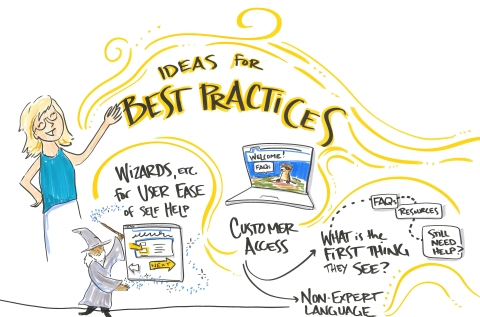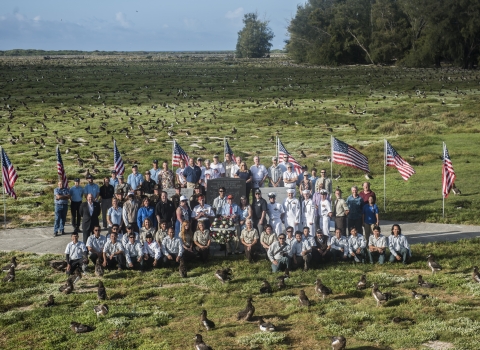Wait, I need a permit for that?
An alligator farm supplying skins to fashion designers. A person preparing for a move abroad with their beloved pet parrot. A musician traveling internationally with their guitar, which is made from a protected tree species. All of these needs and more may require a permit.
For those embarking on their first permit application with the U.S. Fish and Wildlife Service, the process can be confusing. Not only do they need to apply for a permit, they also must figure out which permit. There are over 80 different application options on the ePermits site to choose from, so it’s quite a menu to sort through.
Time for Some Wizardry
For those wishing they could just wave a wand and get the permit they need, well, they’re in luck! (Kinda). While we have yet to figure out a magical way for permit applications to submit themselves, we are working on the first step in that process – locating the right application. By developing a permit application “wizard”, akin to a guided question walkthrough, prospective permit applicants will be led step-by-step to a recommended permit application.
Figuring out how a web-based wizard should work takes some experimentation. There’s key information that's needed in order to match a prospective applicant to a permit application:
- the species in question,
- the law(s) it’s protected by, and
- the activity the applicant needs a permit for.
Other attributes, like the age and origins, may also factor in.
The Tri-Wizard Tournament
We conjured up three different prototypes to assess what questions to ask, and in which order and format. Then, we conducted usability tests where we had real people interact with the wizards and report on what they liked and what they didn’t. Testing our wizard designs against each other, and gathering user input, helped us create the most powerful wizard of them all.
The first wizard prototype offered the most structured support for users. It began by asking users to choose whether they are applying for a permit for a plant or an animal, then it asked increasingly specific questions to narrow down the options.
The second prototype had users input the name of the species they need a permit for, and then select what they intend to do with the species from a pre-populated list of options.
And the third prototype had users self-identify from a list of user groups or “personas” (i.e., sport hunter, exotic pet owner , energy company, etc.) and asked a few more tailored questions from there. Most user groups have a specific handful of applications they work with, so we hypothesized that allowing users to select their persona could be a potential shortcut to the relevant applications.
We wanted to know which prototypes were easiest to use, and how often our testers were successfully transported to the correct permit application. To help, we recruited test participants from the ePermits Team and the USFWS permit processing community (round one of testing), and then from members of the public that have used ePermits for their applications (round two).
For the first round of testing, participants rated the wizard designs on a variety of different criteria (speed, ease of use, enjoyment, confidence, and knowledge). Based on this information and their feedback, we performed some alchemy to improve all three designs before the next round of testing.
The second set of tests consisted of observing applicants and permittees navigating the prototypes in real time, to identify and fix any remaining traps and trickery. We could then confidently select our winning design, knowing all our wizards had been put to the test.
Lessons Learned
These rounds of testing have taught us a thing or two about how to design the most enchanting permit application wizard, such as:
- Avoid information overload. Directions need to be short, clear, and concise. Providing too many choices was confusing, and often led users to panic and become ensnared in whatever option they saw first. At its best, the design and layout of the page should intuitively guide the user to what they need to do next, like magic.
- Do more with less. Users should only be asked a few simple questions that they can confidently answer. Asking users to navigate to other websites to look up additional information was consistently vexing. Instead, we need to minimize the information that users must provide and maximize what we do with it. For example, in the future instead of asking the user to check multiple other websites to understand how their species is protected, we can ask them for the species name. Then, abracadabra – our internal database will automatically look up how its protected, and what applications it can be used for, saving the users from searching on their own.
- If no permit is required – say so! If applicants don’t need a permit, it’s important to let them know quickly, before they tumble too far down the rabbit hole.
Visions in the Crystal Ball
With much of the initial testing wrapped up, we’re looking toward the future to continue investigating how to best implement a wizard. The basic structure structure
Something temporarily or permanently constructed, built, or placed; and constructed of natural or manufactured parts including, but not limited to, a building, shed, cabin, porch, bridge, walkway, stair steps, sign, landing, platform, dock, rack, fence, telecommunication device, antennae, fish cleaning table, satellite dish/mount, or well head.
Learn more about structure of the second prototype seems promising, having performed the best throughout our testing. It seemed to be most intuitive to use and lightened the burden of knowledge on the user.
While even the most all-powerful wizard can’t fix every erroneous permit application submission, we hope to eventually help at least some of our users who have gotten lost on their ePermits journey.
Olivia Hemond served as a Fellow with ePermits during the summer of 2024 as part of the U.S. Fish and Wildlife Service’s Directorate Fellows Program. Her project used a human-centered design approach to explore how the agency might best create a permit application wizard.









